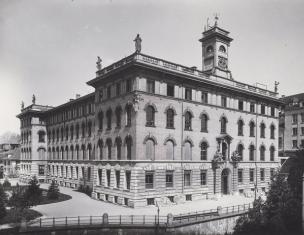The climate in Great Britain is generally mild and temperate, due to the influence of the Gulf Stream. The southwestern winds carry the warmth and moisture into Britain. The climate in Britain is usually described as cool, temperate and humid. British people say: "Other countries have a climate, in England we have weather."
The weather in Britain changes very quickly. One day may be fine and the next day may be wet. The morning may be warm and the evening may be cool. Therefore it is natural for the people to use the comparison "as changeable as the weather" for a person who often changes his or her mood or opinion about something.
The weather is the favourite topic of conversation in Britain. When two Brits are introduced to each other, if they can"t think of anything else to talk about, they will talk about weather. When two people meet in the street, they will often say something weather-related as they pass, just to show their friendliness.
Every daily paper publishes a weather forecast. Both the radio and television give the weather forecast several times each day. The English also say that they have three variants of weather: when it rains in the morning, when it rains in the afternoon or when in rains all day long. Sometimes it rains so heavily that they say "It"s raining cats and dogs". Rainfall is more or less even throughout the year.
In the mountains there is heavier rainfall then in the plains of the south and east. The driest period is from March to June and the wettest months are from October to January. The average range of temperature (from winter to summer) is from 15 to 23 Celsius degrees above zero. During a normal summer the temperature sometimes rises above 30 degrees in the south. Winter temperatures below 10 degrees are rare. It seldom snows heavily in winter, and frost is rare. January and February are usually the coldest months, and July and August the warmest. Still the wind may bring winter cold in spring, or on summer days. Sometimes it brings whirlwinds or hurricanes. Droughts are rare.
So, we can say that British climate has three main features: it is mild, humid and changeable. That means that it is never too hot nor too cold. Winters are extremely mild. Snow may come but it melts quickly. In winter the cold is a humid cold, not of the dry variety. This humid and mild climate pattern is good for plants. Trees and flowers begin to blossom early in spring.
In British homes there has been no central heating up till recently. The fireplaces are often fired-up, but coal is not used as it"s very expensive, so people use wood instead for fireplaces. Britain doesn"t have any high-grade coal, and has to import it into the country. Many schools and universities don"t have any central heating either, and the floors there are made of stone. The typical British bedroom is especially cold, and sometimes electric blankets or hotwater bottles are used.
Britain was originally a land of vast forests, mainly oak and beech in the Lowlands and pine and birch in the Highlands, with broad stretches of marshland and smaller areas of moors. Over the course of time, much of the forest land was cleared and almost all Lowlands outside the industrial areas were cultivated. Today only about 6 per cent of the total land area remains wooded. Extensive forests remain in eastern and northern Scotland and in southeastern and western England. Oak, elm, ash, and beech are the commonest trees in England, while Scotland has a lot of pine and birch. The Highlands are largely moorland with heather, grasses and shallow soil.
In the cultivated areas that make up most of Britain, there are many wild flowers, flowering plants and grasses. The fauna or animal life of Britain is much like that of northwestern Europe, which the UK used to be a part of. Many larger mammals such as bear and wolf have been hunted to extinction, while others are now protected by law. In addition, there are many foxes. Otters are common along rivers and streams, and seals live along much of the coast. Hedgehogs, hares, rabbits, rats and mice are numerous. Deer live in some of the forests in the Highlands of Scotland and England. Some 230 species of birds live in Britain, and another 200 varieties are regular visitors, many are songbirds. The most numerous are blackbirds, sparrow and starling. Robin Redbreast is the national bird of Britain. The number of ducks, geese and other water fowl has diminished during recent years. There are many threats to both the wildlife and ecological balance around the coast. The biggest threat to the coastline is pollution. Even much-loved Blackpool is not officially safe. More than 3.500 million tons of industrial waste is pumped into the North Sea every year. "We cannot continue to use our seas as a dustbin and expect our coastline to survive," says Greenpeace. Many other ecological problems may be caused by privatization of the coast. Many of the rivers are "biologically dead", and therefore unable to support fish and wildlife.
Great Britain is situated on the islands. It is washed by seas from all the sides. That’s why the climate and the nature of Great Britain are very specific. It is not very cold in winter and never very hot in summer. There is no ice on the lakes and rivers in winter. It seldom snows. It rains very often in all the seasons. The weather changes very often. All this is due to the influence of the Gulf Stream.
Mark Twain once said about America: “If you don’t like the weather in New England, just wait a few minutes”, but it is more likely to have been said about England. Britain is also famous for its fogs. Sometimes fogs are so thick that it is impossible to see anything within 2 or 3 metres.
The English also say that there are three variants of weather: when it rains in the morning, when it rains in the afternoon or when it rains all day long. The driest period is from March to June and the wettest months are from October to January. The average temperature is from 5 to 23 degrees above zero. Sometimes the temperature rises to 30 degrees above zero in summer and falls to 10 degrees below zero in winter.
So, we may say that the British climate has three main features: it is mild, humid and changeable. This humid and mild climate is good for plants. Trees and flowers begin to blossom very early in spring.
Климат Великобритании
Великобритания расположена на островах. Она омывается морями со всех сторон. Вот почему климат и природа Великобритании весьма специфичны. Это не очень холодная зима и не очень жаркое лето. В зимний период здесь нет льда на реках и озерах. Снег выпадает очень редко. Зато дожди идут во все времена года. Погода меняется очень часто. Все это из-за влияния Гольфстрима.
Марк Твен однажды сказал об Америке: "Если вам не нравится погода в Новой Англии, подождите несколько минут", но это скорее всего было бы правильно сказать об Англии. Великобритания также славится своими туманами. Иногда туман настолько густой, что невозможно увидеть что-либо за 2 или 3 метра.
Англичане также говорят, что есть три варианта погоды: когда идет дождь утром, когда идет дождь во второй половине дня или в течение всего дня. Самый сухой период - с марта по июнь и самые влажные месяца - с октября по январь. Средняя температура составляет от 5 до 23 градусов выше нуля. Иногда температура поднимается до 30 градусов выше нуля летом и падает до 10 градусов ниже нуля зимой.
Таким образом, мы можем сказать, что британский климат имеет три основные черты: он мягкий, влажный и изменчивый. Этот влажный и мягкий климат хорош для растений. Деревья и цветы начинают цвести очень рано весной.
В нашей статье мы хотим поговорить о Великобритании. Это далекая страна часто ассоциируется у нас с туманами и частыми дождями. Но интересно, каковы же особенности природы и климат Великобритании?
Климатические условия
Безусловно, на температурный режим влияет и высота над морем - в горах и на холмах намного прохладнее, нежели в долинах. Поэтому на холмистой местности Уэльса, а также в большей части Шотландии намного холодней зимой и менее жарко летом, чем в остальных регионах Англии.
В летний период температура здесь редко доходит до +32°С, а зимой не опускается ниже -10°С. И тем ни менее, есть значительная разница между югом и севером. Так, на Шотландских островах среднемесячная температура колеблется от +3°С в зимний период и до +11°С в летний.
Природа Великобритании во многом сходна со Европы. И это вполне логично, поскольку отделились сравнительно недавно. На климат описываемого региона огромное влияние оказывает близость Северо-Атлантического течения. Потому-то здесь и преобладают умеренные температуры, повышенная влажность и большое количество поверхностных вод.
Особенности географического положения
На климат, безусловно, влияет океан и течение Гольфстрим. Для англичан привычной погодой является дождь и каждодневная сырость. Наиболее суровы погодные условия в Северной Шотландии, ее горной части и в Уэльсе.
О влиянии океана на погоду свидетельствует преобладание неустойчивой погоды с густыми туманами и сильными порывистыми ветрами. Зимы здесь, кстати, необычайно мягкие, но в тоже время влажные.
Морской юго-западный воздух повышает температуру в холодное время года, но в тоже время приносит дождливую и пасмурную погоду со штормами и ветрами. Когда же вторгается холодный воздух с северо-востока, то становится достаточно морозно. Все это и делает особенно заметными особенности природы Великобритании.
Снега покрывают всю территорию страны. В зимний период они особенно обильны в Шотландии. А на юге Англии они, как правило, редко бывают - здесь даже трава зеленеет круглый год.
Великобритания: природа
Территория Великобритании по рельефу условно делится на два региона:
- Высокая Британия (вместе с Северной Ирландией), которая находится на западе и севере страны и представляет собой сильно отделенные друг от друга возвышенности и низменности.
- Низкая Британия, расположенная на востоке и юге, для которой характерна холмистая местность с маленькими возвышенностями.
На особенности природы Великобритании влияет и тот факт, что условная граница между двумя регионами не везде заметна - в некоторых местах она сглажена. Тянется названная граница от Ньюкасла в юго-западном направлении.
Леса Великобритании
Путешествуя по стране, отчетливо замечаешь, как быстро сменяют ландшафты друг друга. Вообще, Великобритания, природа которой весьма разнообразна, может похвастаться богатой растительностью.
Ее особенностиобусловлены климатическими условиями и ландшафтом. Так, например, Высокая Британия - это крайне туманный, ветреный и дождливый регион, что, конечно же, сказывается и на растительности края. А Уэльс - горный регион, украшенный разнотравьем и вересковыми пустошами, где пасутся овцы.
В доисторическое время дикая природа Великобритании представляла собой очень густые леса из липы, дуба березы, бука. Местные жители считали священными многие растения, а особенно почитали дубы. Это было связано с их древними верованиями. Однако шли столетия и многое изменилось.
К концу двадцатого века леса Великобритании в значительной мере были уничтожены, благодаря хозяйственной деятельности человека. Люди вырубали могучие деревья, осушали болота, что и привело к серьезным изменениям видового состава флоры и фауны. В страну были завезены и насажены экзотические деревья, которых здесь ранее не было (пихта, ель, лиственница).
В настоящее время леса в стране занимают всего 10% всей площади. Большая их часть уцелела на горных склонах, в долинах рек и на юге региона. В настоящее время характерные растения Великобритании - бук, ясень, граб, вяз, дуб. А вот в Грампианских горах произрастают елово-сосновые леса с дубовыми рощами.
Зеленая страна
Несмотря на то что в стране больших лесных массивов уже не существует, все равно складывается впечатление, что это зеленый край. Великобритания, природа которой серьезно пострадала от рук человека, занимается искусственным насаждением лесополос между полями, защитных изгородей от холодных ветров, формирует заказники.
Кроме лесов, страна богата верещатниками, без которых не было бы полным данное описание природы. Великобритания богата также травянистыми пустошами, которые сохранились на неосвоенных участках земли.
В лесах страны даже сейчас водятся косули, лани, куницы, кролики. А реки и озера могут похвастаться лососем и форелью. Прибрежные воды, омывающие береговую линию, насыщены треской, сельдью и пикшей.
Птицы Великобритании
Великобритания стала домом для множества птиц, здесь их насчитывается более двухсот разновидностей. Приблизительно половина из них гостит на территории страны, прилетая из других краев. Деятельность человека оказала влияние и на птиц. Численность некоторые видов настолько сократились, что находится на гране вымирания, а популяции других, наоборот, возросли.
После массового осушения болот сократилась численность водоплавающих. А освоение земель привело к уничтожению некоторых разновидностей растений, что, в свою очередь, сказалось на птицах. Зато голуби и воробьи замечательно прижились в больших городах, увеличивая с каждым годом свою популяцию.
Для восстановления численности исчезающих видов в государстве создаются заповедные зоны с природоохранным режимом. Их в Великобритании достаточно много. Надо сказать, англичане не жалеют средств на содержание природных парков, которые они называют краем непуганых диких птиц.
Дело в том, что многочисленные их пернатые жители совершенно не боятся людей. А лебеди в стране вообще пользуются всенародной любовью. Их появление здесь в далекие времена связывают с одной очень красивой легендой. И в настоящее время эти пользуются особым статусом. Ежегодно их маркируют, дыбы вести учет их количества.
Геральдические животные
Великобритания - удивительная страна с давней историей. Ее жители с давних времен трепетно и уважительно относились ко многим растениям, наделяя их мифическими свойствами и возможностями. Не меньший вклад внесли и животные, ставшие на многие века символами целых королевских династий. Поэтому, говоря о природе Англии, нельзя не упомянуть и геральдику.
Впервые символические изображения животных ввел король Ричард Львиное сердце. Именно на его гербе в качестве символа мужества появились три золотых льва.
Позже львы стали геральдическими символами многих дворянских семей. Кроме них, также встречаются и совершенно мифические существа, такие, как драконы, грифоны, единороги. Кстати, до сих пор в Тауэре обитает пять воронов, которые считаются символом неприступности крепости, такая традиция уходит своими корнями в далекую историю.
The Climate of Great Britain (1)
Great Britain is situated on islands. It is washed by seas from all sides. That"s why the climate and the nature of Great Britain is very specific. The popular belief that it rains all the time in Britain is simply not true. In fact, London gets no more rain in a year than most other major European cities. Generally speaking, the further west you go, the more rain you get. The mild winters mean that snow is a regular feature of the higher areas only. The winters are in general a bit colder in the east of the country than they are in the west. While in summer, the south is slightly warmer and sunnier than the north. Besides Britain is famous for I fogs. Sometimes fogs are so thick that it is impossible to see anything within 2 or 3 metres.
Why has Britain"s climate got such bad reputation? Maybe it is for the same reason that British people always seem to be talking about the weather. There is a saying that Britain doesn"t have a climate, it only has weather. You can never be sure of a fry day, though it may not rain very much altogether. There can be cool and even cold days in July and some quite warm days in January.
The weather changes very often. Mark Twain said about America: "If you like the weather in New England, just wait a few minutes" but it is more likely to have been said about England. The lack of extremes is the reason why on the few occasions when it gets genuinely hot or freezing cold, the country seems to be totally unprepared for it. A bit of snow, a few days of frost and the trains stop. working and the roads are blocked. If the thermometer goes above 2ГС, people behave as if they were in Sahara and the temperature makes front-page headlines. These things happen so seldom that it is not worth organizing life to be ready for them. Everyone who comes to Great Britain says that it looks like one great beautiful park. The British people love their country and take care of it.
Климат Великобритании (1)
Великобритания расположена на островах. Со всех сторон она омывается морями. Поэтому климат и природа Великобритании очень специфичны. Распространенное мнение о том, что в Британии все время идет дождь, не совсем верное. На самом деле в Лондоне за год выпадает не больше осадков, чем в большинстве других европейских городов. В целом, чем дальше на запад, тем количество осадков больше. Мягкие зимы предполагают наличие снега только на возвышенностях. Зимы в общем более холодны на востоке страны, чем на западе. В то же время летом на юге теплее и солнечнее, чем на севере. Кроме этого, Британия знаменита своими туманами. Иногда туманы такие густые, что невозможно что-нибудь увидеть на расстоянии 2 или 3 метров.
Почему климат Британии имеет такую плохую репутацию? Может быть, это потому, что британцы, кажется, постоянно говорят о погоде. Существует поговорка, что Британия не имеет климата, она имеет только погоду. Вы никогда не можете быть уверены, что будет сухой день, хотя может и не быть сильного дождя. Могут быть прохладные и даже холодные дни в июле и теплые дни в январе.
Погода меняется очень часто. Марк Твен сказал про Америку: "Если вам не нравится погода в Новой Англии, подождите несколько минут", но это больше похоже на сказанное про Англию. Отсутствие резких контрастов - причина того, что в некоторых случаях, когда становится очень жарко или холодно, страна кажется неподготовленной к этому. Немного снега и несколько дней мороза - и перестают ходить поезда, а дороги оказываются заблокированными. Если термометр показывает больше 2ТС, люди ведут себя, как в Сахаре, а температура воздуха становится темой первых страниц газет. Но эти вещи случаются так редко, что нет смысла специально к этому готовиться. Каждый, кто приезжает в Англию, говорит, что она выглядит как один большой красивый парк. Англичане любят свою страну и заботятся о ней.
Questions:
1. Why is the
climate and the nature of Great Britain very specific?
2. What is Britain famous for?
3. Why has Britain"s climate got such a bad reputation?
4. The weather in Britain is very changeable, isn"t it?
5. Does it rain often?
Vocabulary:
feature - особенность
genuinely - неподдельно
fog - туман
headline - заголовок
The climate in Great Britain is generally mild and temperate due to the influence of the Gulf Stream. The south-western winds carry the warmth and moisture into Britain. The climate in Britain is usually described as cool, temperate and humid.
British people say: "Other countries have a climate, in England we have weather."
The weather in Britain changes very quickly. One day may be fine and the next day may be wet. The morning may be warm and the evening may be cool. Therefore it is natural for the people to use the comparison "as changeable as the weather" of a person who often changes his mood or opinion about something. The weather is the favourite topic of conversation in Britain. When two Englishmen are introduced to each other, if they can"t think of any thing else to talk about, they talk about weather. When two people meet in the street they will often say something about weather as they pass, just to show their friendliness.
Every daily paper publishes a weather forecast. Both the radio and television give the weather forecast several times each day.
The English also say that they have three variants of weather: when it rains in the morning, when it rains in the afternoon or when in rains all day long. Sometimes it rains so heavily that they say "It"s raining cats and dogs".
Rainfall is more or less even throughout the year. In the mountains there is heavier rainfall then in the plains of the south and east. The driest period is from March to June and the wettest months are from October to January. The average range of temperature (from winter to summer) is from 15 to 23 degrees above zero. During a normal summer the temperature sometimes rises above 30 degrees in the south. Winter temperatures below 10 degrees are rare. It seldom snows heavily in winter, the frost is rare. January and February are usually the coldest months, July and August the warmest. Still the wind may bring winter cold in spring or summer days. Sometimes it brings the whirlwinds or hurricanes. Droughts are rare.
So, we may say that the British climate has three main features: it is mild, humid and changeable. That means that it is never too hot or too cold. Winters are extremely mild. Snow may come but it melts quickly. In winter the cold is humid cold, not the dry one.
This humid and mild climate is good for plants. The trees and flowers begin to blossom early in spring.
In the British homes there has been no central heating up till recently. The fireplaces are often used. but the coal is not used as it"s very expensive. Britain has no good coal now and imports it itself. Many schools and universities have no central heating either, and the floors there are made of stone. The British bedroom is especially cold, sometimes electric blankets or hotwater bottles are used.








